THE GRANADA THEATRE CIRCUIT
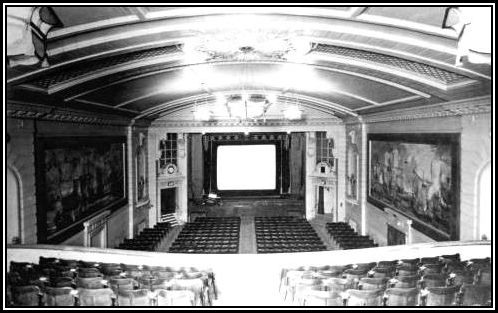 The Palace Cinema Slough destroyed by fire on V.J. night and rebuilt as The Century Theatre; a Spurden-Rutt Organestra Organ was installed in the Theatre and its console is visible on the left-side of the Orchestra Pit (an identical Organestra was installed at the Super Cinema Oxford)
The Palace Cinema Slough destroyed by fire on V.J. night and rebuilt as The Century Theatre; a Spurden-Rutt Organestra Organ was installed in the Theatre and its console is visible on the left-side of the Orchestra Pit (an identical Organestra was installed at the Super Cinema Oxford)
—ooOoo—
PART TWELVE:
THE SLOUGH GRANADAS & MISS CANDY
PAGE TWO:
THE CENTURY THEATRE OF SLOUGH
and
THE AMBASSADOR SLOUGH & THE ESSOLDO CIPPENHAM
-oOo-
At the time of our move to Langley in November 1956, the town had three cinemas in its centre. All three were operated by the Granada Theatre Circuit and were the Granada, the Century and the Adelphi Theatres.
In addition, there were two other cinemas outside of the centre: the Ambassador in the area of Franham Royal and the Essoldo in Cippenham, which was an area west of Slough along the Bath Road (Great West Road, A4).
The Ambassador opened in 1936 and was taken over by The Rank Organisation in 1937 who operated it as an Odeon Cinema until February 1968 when it closed and re-opened as a Top Rank Bingo Club. Despite it being part of the Rank Organisation, its name was never changed. I only went to this cinema once and remember that it had a pleasant enough foyer and auditorium. Sadly, the only thing I can remember about the cinema was that there were potted palms in the foyer. At the time I was not overly familiar with the distinctions in decor of the cinema circuits, but I am certain that despite it being an Odeon, its decor did not resemble that of the Odeon Hackney Road, which was splendid in chocolate and gold.
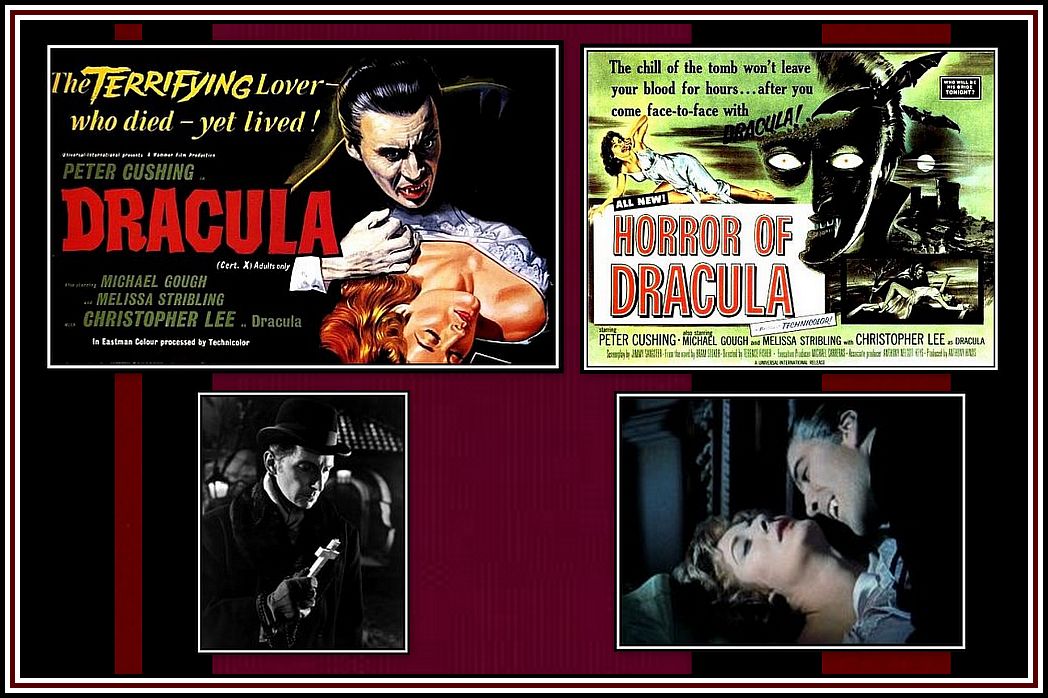 Dracula 1957
Dracula 1957
Bottom Left: Peter Cushing; Bottom Right: Christopher Lee
I only went once to the Ambassador Cinema and that was in 1958. I had gone with two classmates to see Dracula. The film had been given an X-Certificate by the British Board of Censors and so one had to be 16-years of age to be allowed to see it. We were underage at the time, but were granted entry without difficulty and once inside we found an empty row close to the screen and sat down in the middle of it where we smoked constantly throughout the screening.
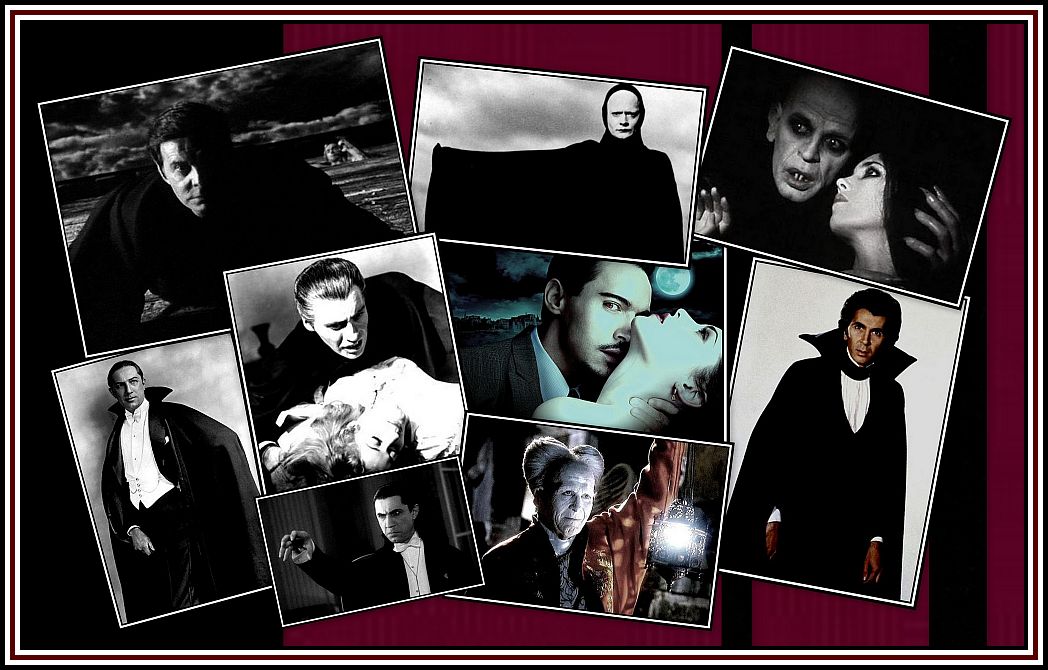 Dracula (& Death) in Film and Television (1977)
Dracula (& Death) in Film and Television (1977)
I remember that the film was rather creepy in parts and later felt somewhat apprehensive during my journey home. Once I got off the bus, I had to walk down Langley Broom ……. alone …… in the dark ……. with only the sounds of the rustling trees for company! At that time, there were no street lamps in Langley Broom and the surface was not paved. The Broom was treacherous enough by day, as the surface was of mud and gravel and had numerous huge puddles full of dirty water throughout its length. The walk was dangerous at night as one could easily stumble into one of the cavernous puddles and not only receive a soaked foot, but possibly a twisted ankle in addition.
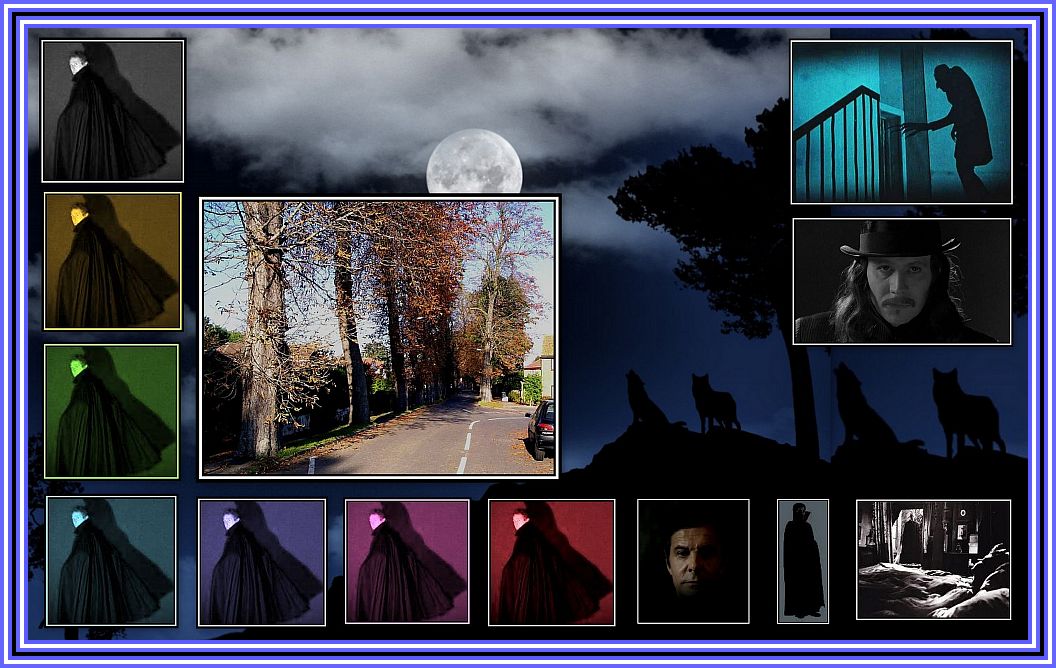 Langley Broom as it was in 1958
Langley Broom as it was in 1958
Centre: Langley Broom in 2006
Today, gone are the huge puddles and many of the trees …….
several street lamps have been added …….
the road is now paved and a few houses have been built …….
it now looks very innocent …….
just another quiet tree lined roadway …….
but who can say what happens when the sun goes down
and the lights are extinguished …….
perhaps the Children of the Night come out to play and make music!
I can still remember my walk that night. There was no moon thankfully, as I am sure that every shadow would have resembled Dracula! I would have imagined him waiting for me with his cloak billowing slightly from the cold wind that blew and with that dreadful smirk on his face. However, although there was no moon to taunt me with shadows, there was plenty of sound to send shivers down my spine. As I crept gingerly through the mire, I was made aware that perhaps I was not alone. I felt a constant torment from the sounds of the rustling of the trees and by what seemed to be a multitude of the violent animals who were waiting with impatience to tear me to shreds,
It is of interest to note that close to the location of the Ambassador Cinema is the Britwell Housing Estate, which was another estate built for Londoners in need of rehousing. At about the time when my parents were thinking of moving to the area, Britwell Estate had already gained a bad reputation. Once my mother heard tales of the place, she made it clear that she would not move there and, luckily for us, we were not offered a home there.
In 1956, the estate was part of Farnham Royal in the County of Buckinghamshire. In 1972, Britwell was transferred to the the County of Berkshire and became part of the Municipal Borough of Slough. Since Buckinghamshire was a very country county, I feel sure that the presence of those rowdy groups from London living at Britwell and Langley did not suit its county image and Bucks was happy to see the back of the estate and its people!
—ooOoo—
The Essoldo Cinema was in Cippenham, which was west of Slough, along the Bath Road. In 1920, an area of Cippenham was used to form a business park, which became Slough Trading Estate. Slough Trading Estate is the largest business park that is in single private ownership in Europe and was the first of its type to be formed in the world.
The Essoldo Cinema opened in 1938 as the Commodore and the building also included a dance hall and a cafe and was equipped with a Hammond (La Fleur) Organ.
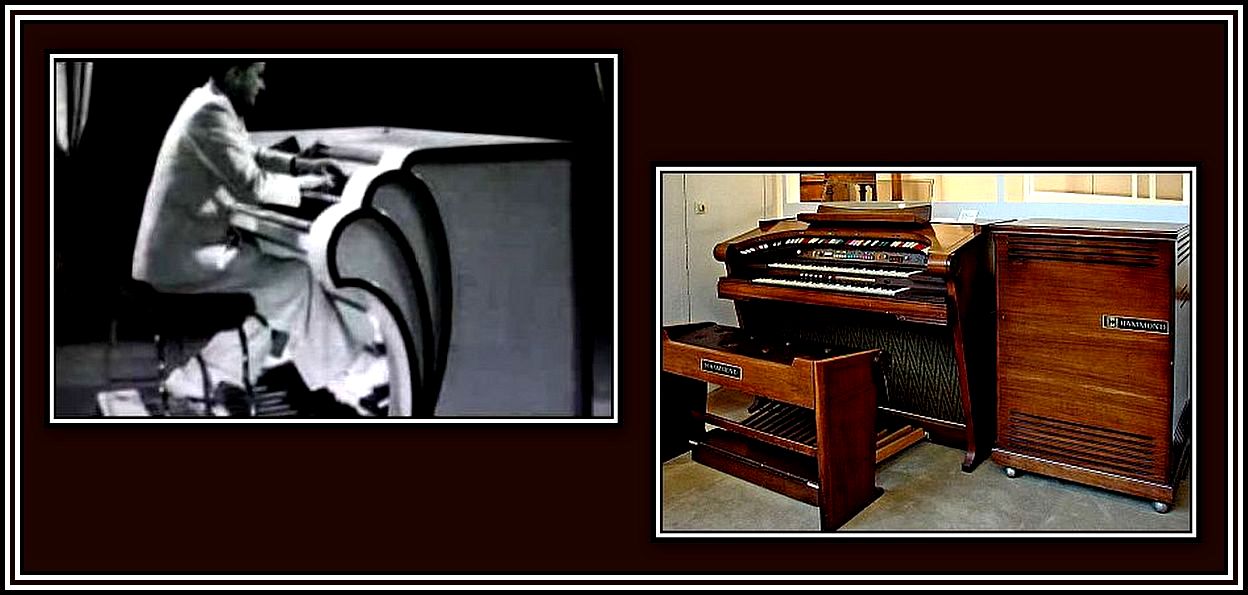 Hammond Organs
Hammond Organs
Left: Harold Ramsey at the Hammond La Fleur Organ
(click here to hear Mr. Ramsey play the organ)
Right: Hammond Regent 4172 (a transistor organ)
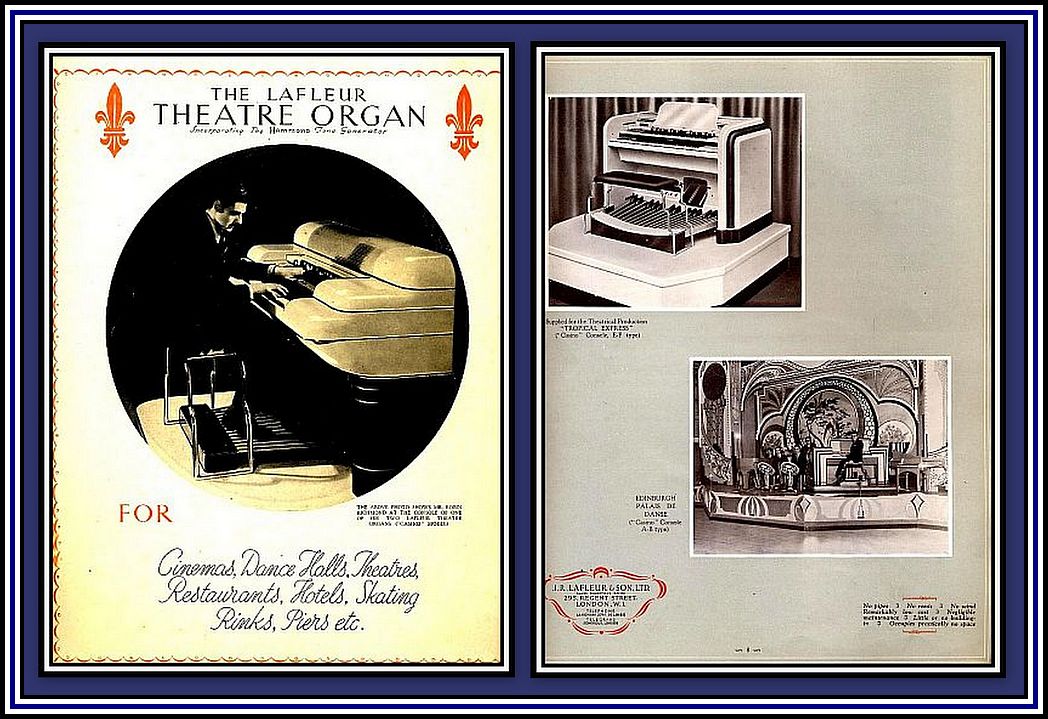 Hammond Organs in the UK Photographs from the the La Fleur Theatre Organ Brochure
Hammond Organs in the UK Photographs from the the La Fleur Theatre Organ Brochure
Left: Page 1, Robin Richmond at the La Fleur Organ; Right: Page 8 of the brochure
The following information regarding the Hammond Organ was sent to me recently:
The history of the Hammond Organ Company, based in Chicago, is interesting and worth further investigation. In the UK, it was hoped that they would take off as church organs, hence the use of the alternative Lafleur brand for entertainment use – but the key markets for Hammond have always been entertainment and home organs. They remain popular with jazz and pop groups, as well as home organ enthusiasts.
The method of tone generation is ingenious and, in the early days, much was made of the fact that they were pipeless and hence portable. Former Cinema Organ Society President Robin Richmond was on the point of ordering a portable Christie Theatre Pipe Organ to take on tour around the variety theatres, but then the first Hammond Organ came out and Robin bought one of those instead.
Sent by Mr. Simon Gledhill, Chairman Cinema Organ Society
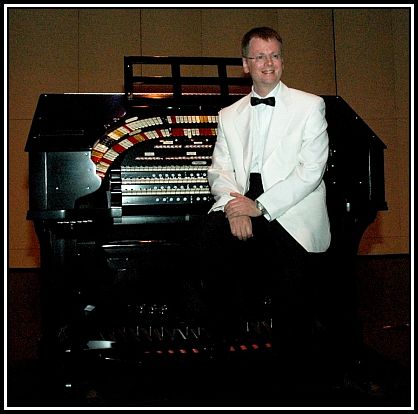 Simon Gledhill seated at the Wurlitzer Organ at Olympia, WA
Simon Gledhill seated at the Wurlitzer Organ at Olympia, WA
(The photographer of this photograph is unknown at this time)
—ooOoo—
The cinema was taken over by the Essoldo Cinema Circuit in 1949 and its name was changed in 1950. It closed in March 1965 and became an Essoldo Bingo Club until 1970 when it was demolished.
I only went to the Essoldo Cinema on one occasion and that was to see The Ten Commandments. This film was not shown in the Slough Cinemas and so necessitated going to Cippenham to see it. Again, sadly, I do not remember very much about the interior of the cinema except that it was very dark and not particularly attractive at that time. I do remember that the screen was not especially large and certainly not of the size I was used to at the Essoldo Cinema in Bethnal Green.
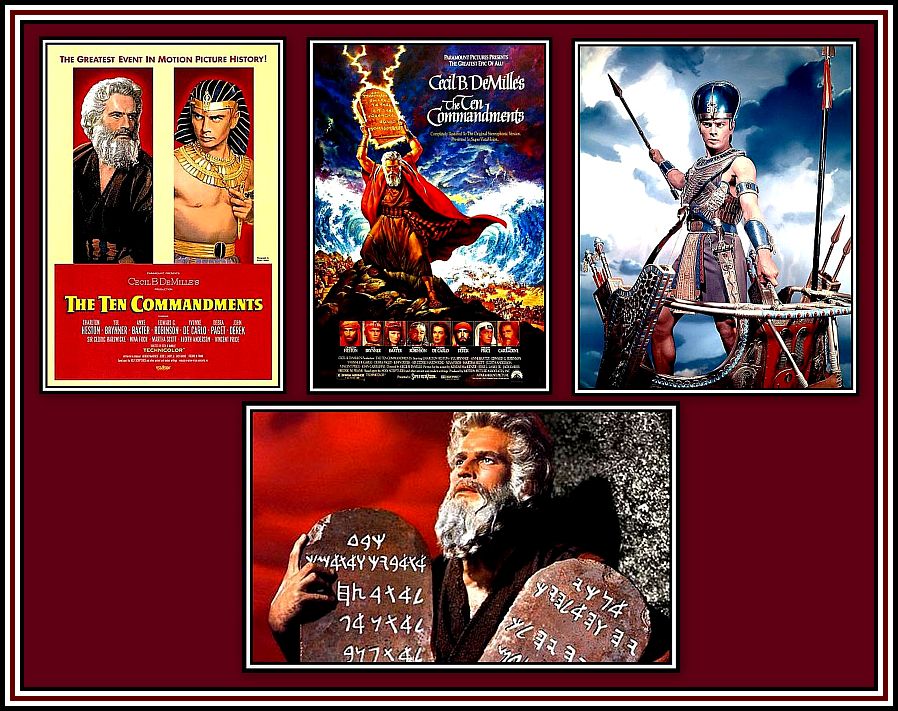 The Ten Commandments (1956)
The Ten Commandments (1956)
Top Left: Original Film Poster; Top Centre: The DVD Cover
Top Right: Yul Brynner as Rameses
Bottom: Charlton Heston as Moses
I don’t remember any of the 20th Century Fox CinemaScope Productions being shown at the Essoldo Cippenham while I lived in Langley. I remember that there was one small billboard on the wall of an alleyway in Slough, which was just noticeable as one walked by that advertised the films being shown there each week. I remember that most were definitely films of less than sterling quality and rarely made by the major studios. It did, however advertise for one week only one of the early Rock ‘n’ Roll films, Shake Rattle and Rock. I wanted to see this film, as it featured both Fats Domino and Big Joe Turner, who were and still are, great favourites of mine. I was unable to go as I did not have sufficient money for the bus fare and a cinema ticket at the time.
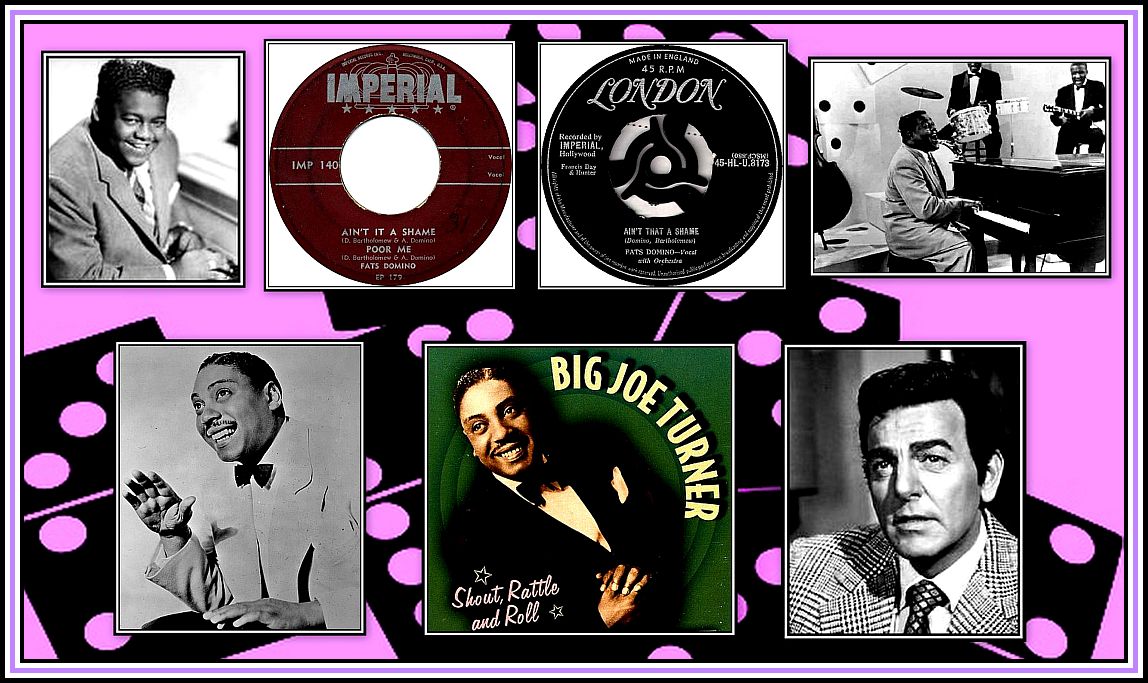 Shake, Rattle & Rock (1956)
Shake, Rattle & Rock (1956)
Top: Fats Domino; Centre: Ain’t That a Shame (U.S. & UK discs)
Top Right: scene from the film, Disc Jockey Jamboree (1957)
Bottom Left: Big Joe Turner; Centre: album cover
Bottom Right: Mike Connors
I always felt deprived at not seeing the film. However, everything comes to he who waits, but the result may not always be as we hoped! Years later, thanks to television, I eventually saw Shake, Rattle and Rock. I am sorry to say that not even the presence of Fats Domino or even Big Joe Turner was able to save this film although it was great to see and hear them. To be honest, the film was made, like so many of the era, on the cheap and was merely a means to showcase the singers and make money quick. With these films, any plot or acting was purely incidental. I was surprised to see that it was one of Mike Connors early film roles and made before either Tightrope or Mannix.
—ooOoo—
THE CENTURY THEATRE & MISS CANDY
-oOo-
The first cinema that I noticed in Slough was the Century Theatre. This was during our first trip to check out Slough and environs prior to moving there. I remember passing it on the 81 bus that we took from Slough Station to Langley Broom. It was about halfway along the High Street. Sadly, I evidently noticed little of its exterior, I am ashamed to say, since I cannot recall what it looked like.
 The Various Bus Types that have operated on the 81 Bus Route over the years
The Various Bus Types that have operated on the 81 Bus Route over the years
I am certain that despite my inability to remember any details of the building’s exterior, I do not doubt that I believed it to be a fine looking place. I say this since I found nearly every cinema outside Bethnal Green to be grand, as the cinemas of Bethnal Green were in a poor condition and in great need of restoration. Later, when we went inside the Century Theatre, I remember that it had a lavish foyer decorated in burgundy and gold with several potted palms and a couple of huge pots that could have hidden several of Ali Baba’s thieves! How could I not be impressed? As much as I loved going to the Excelsior in Bethnal Green and the Plaza Cinema on Kingsland Road, going to the Century Theatre was like going to a special cinema, as it was plush!
The Century Theatre was originally built as the Palace in 1921 as an independently owned and operated cinema. An organ was installed later in 1929, but was removed in 1937 when the cinema’s seating capacity was increased from 950 to 1,336 during modernisation.
The cinema closed on V.J. Night, 16th August, 1945, as a result of a fire in the building. The building was eventually taken over in 1949 by Granada Theatres and re-opened on 2nd January, 1950 as the Century Theatre following repairs using plans of the architect George Coles and interior designers Howell Jones and W.F. Mudd.
I remember that on one of our visits to Slough before moving there, my mother decided that we should go to the cinema and we chose the only cinema that we had found until then, the Century.
At last I found something to like in Slough! I had been fortunate enough to go to some of the lavish cinemas in the West End of London and liked them very much.
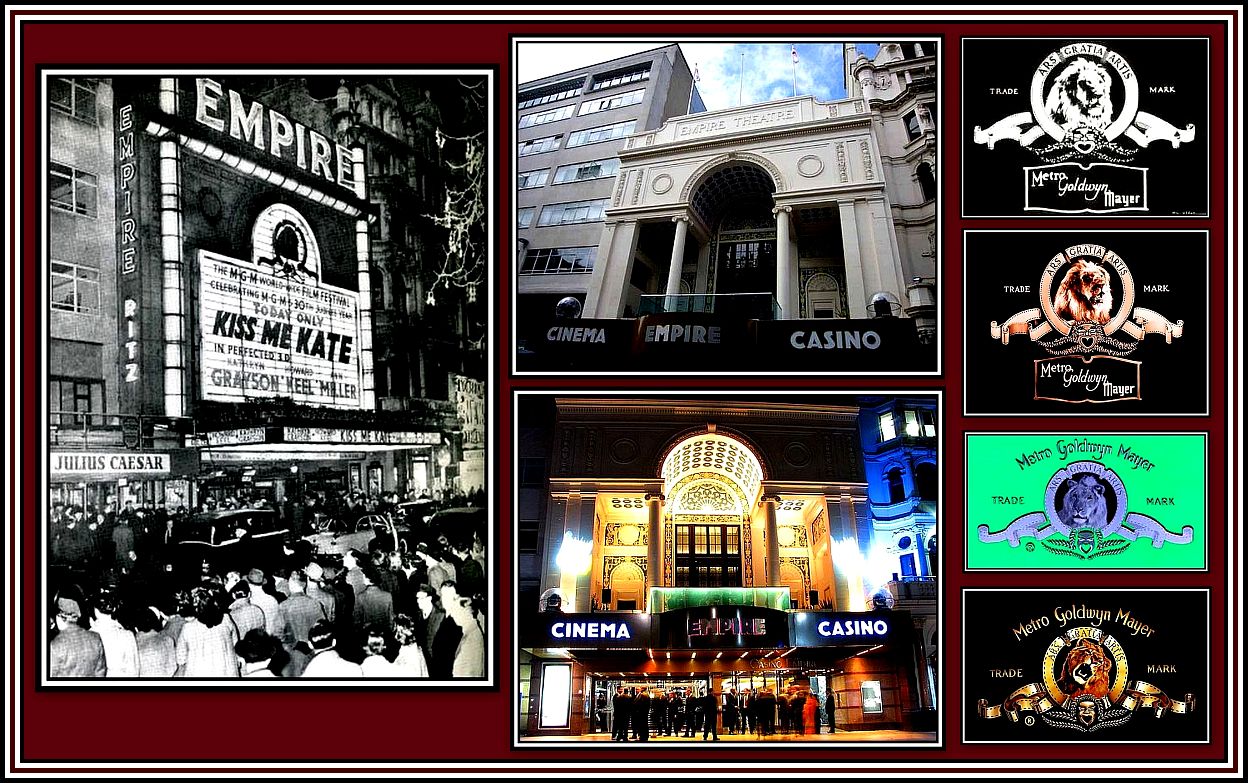 Empire Leicester Square, once London’s Showcase of MGM Pictures
Empire Leicester Square, once London’s Showcase of MGM Pictures
Left: in 1953; Centre: today, by day (Upper) and night (Lower)
Right: MGM Pictures Logos through the years
The green logo was used to introduce
Alfred Hitchcock’s film, North by Northwest (1959)
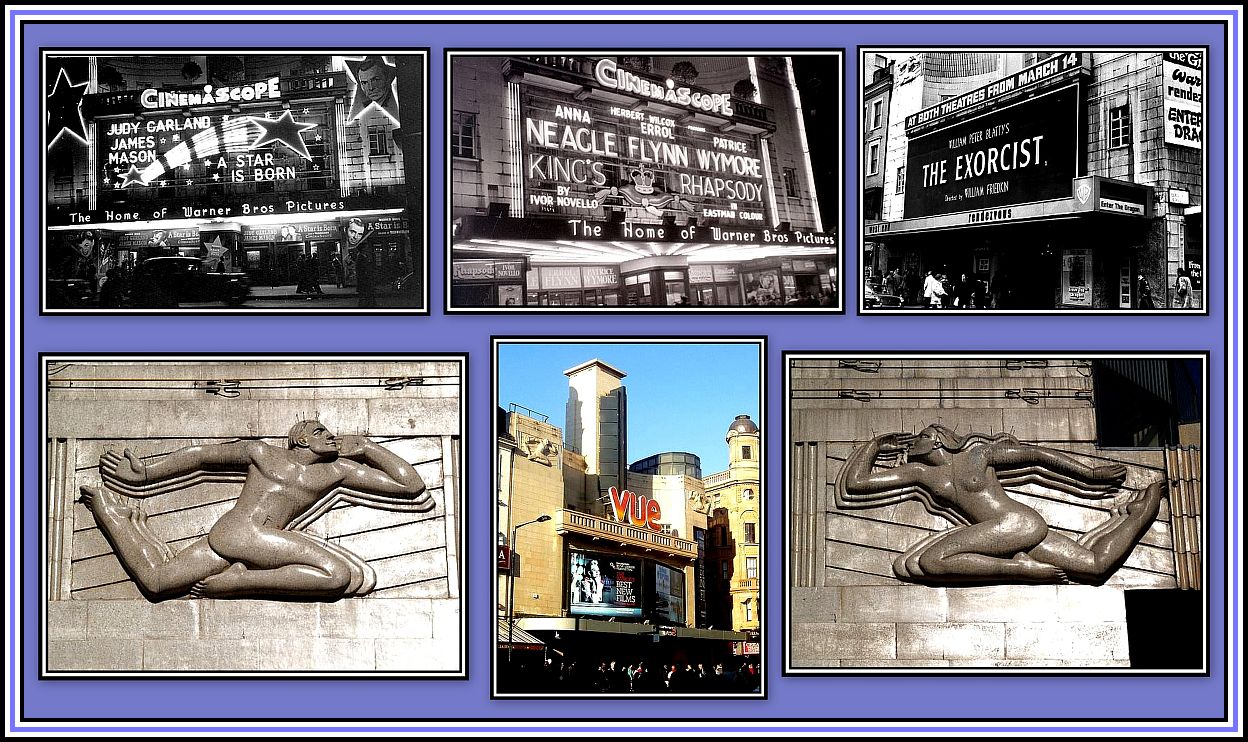 Warner Leicester Square, once London’s Showcase of Warner Bros. Pictures – now The Vue
Warner Leicester Square, once London’s Showcase of Warner Bros. Pictures – now The Vue
The carved side panels (Sight & Sound) were by Bainbridge Copnell
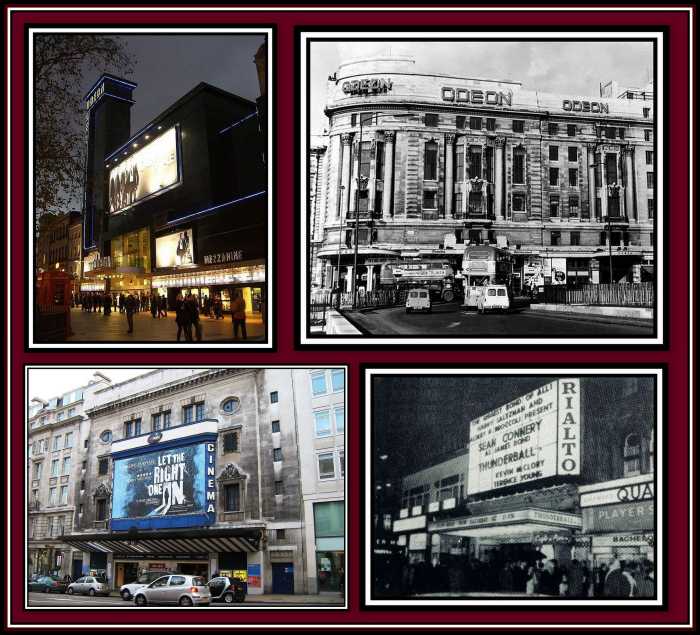 Top Left: Odeon Leicester Square, Top Right: Odeon Marble Arch
Top Left: Odeon Leicester Square, Top Right: Odeon Marble Arch
Bottom Left: Carlton Haymarket; Bottom Right: Rialto Coventry Street
However, until that time, I considered the Odeon Hackney Road to be the most luxurious of our local cinemas. I was also impressed with the Dreamland Cinema, in Margate, which I went to once and saw Walt Disney’s version of Treasure Island (1950).
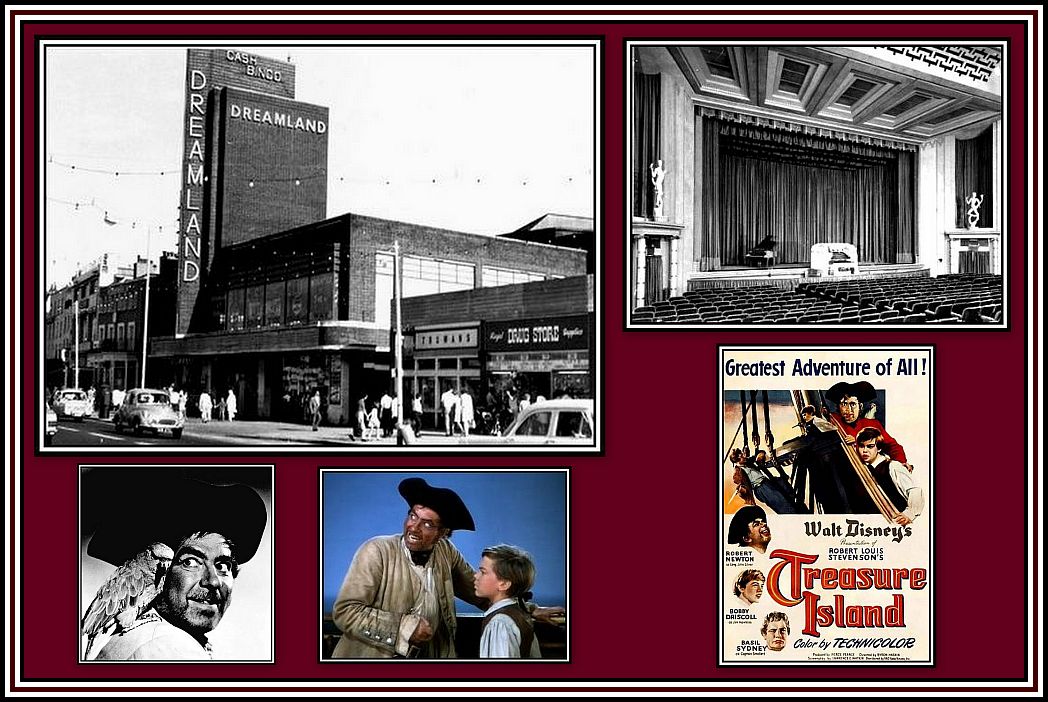 Dreamland Cinema Margate
Dreamland Cinema Margate
Top Left: Exterior; Top Right: Interior at opening
Bottom, Left to right: Robert Newton as Long John Silver;
Robert Newton & Bobby Driscoll as Jim Hawkins; & Film Poster
Although the Excelsior Kinema in Bethnal Green was my favourite cinema, I also really liked the Odeon Hackney Road. This was a beautiful cinema and had an elegance that I was not used to in our other local cinemas. I liked its design and its decor in chocolate and gold colours.
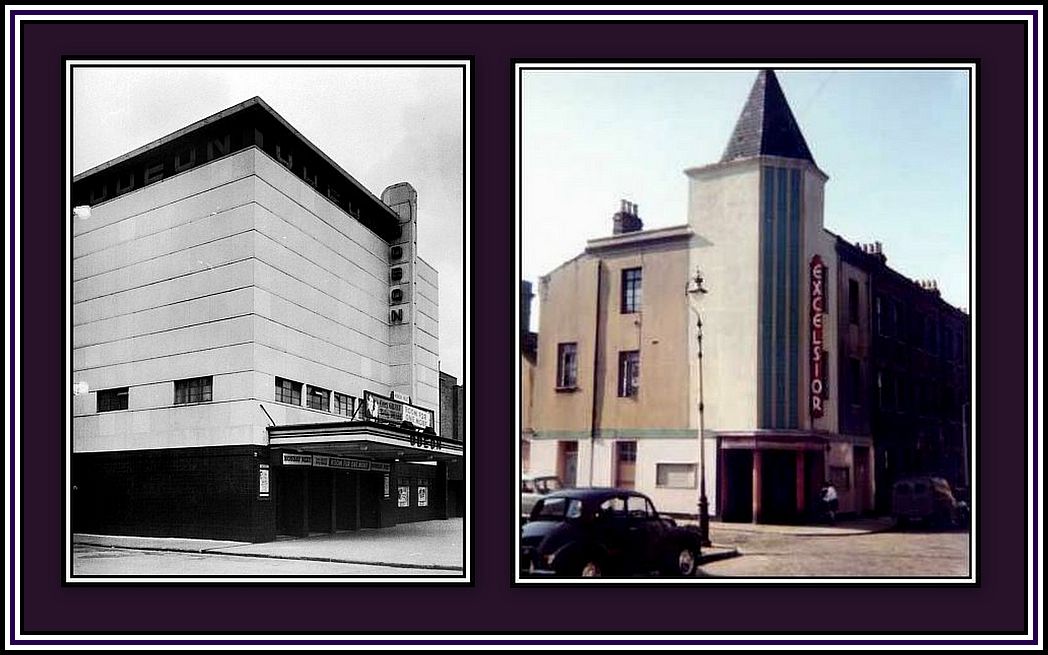 Left: Odeon Hackney Road; Right: Excelsior Kinema Bethnal Green
Left: Odeon Hackney Road; Right: Excelsior Kinema Bethnal Green
However, the Century had an exotic look and feel to it that I had never experienced before. I did not know at the time that it belonged to the Granada Theatre Circuit, and to be honest, I did not even know of the existence of such a circuit. Whenever I looked in the evening newspapers to see What’s On at the Pictures, I don’t remember seeing any mention of a Granada Theatre anywhere. I later learned that the circuit only advertised in local newspapers in areas where they had a presence and since my area of the East End had no presence, there was no advertising for them in the local paper.
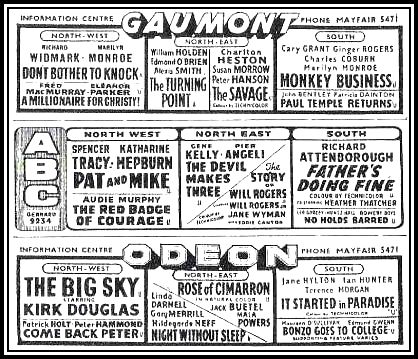 What’s On At The Pictures This Week
What’s On At The Pictures This Week
Something, or rather someone, that I was very much taken with at the Century was the saleslady that sold the tickets in the box office. She was exotic too! In fact, she was the most exotic and beautiful woman that I had ever seen until then. She had amazingly high cheekbones with flashing dark eyes and soft, smooth, silky olive-coloured skin. Her hair was long, straight and jet black in colour and constantly fell across an eye. She gave her head a slight flick and her hair moved to reveal her face once more. I was, to say the least, besotted.
The saleslady was dressed in the Granada Uniform. She wore a light coloured blouse of what I assumed was made of silk or satin, which shone in the light and was buttoned at the back. She appeared to be wearing what I took for pantaloons. She barely spoke and did not smile, which added to her tantalising appeal, which had completely bewitched me! Her obvious charm and allure sent me reeling. I was besotted. I suspect now that she was of Malay or Polynesian heritage of which I knew nothing at the time.
Besides the exotic looking saleslady, I had noticed something else about the Century Theatre that made it an appealing place. This was the presence of a small confectionery shop within the foyer with its own entrance. The establishment was named Miss Candy and was filled with the most colourful succulent sweetmeats in large glass jars. I remember wishing that I had lots of money, as I would have spent it all there and willingly shared my purchases with the exotic box office lady that I have forever thought of as Miss Candy.
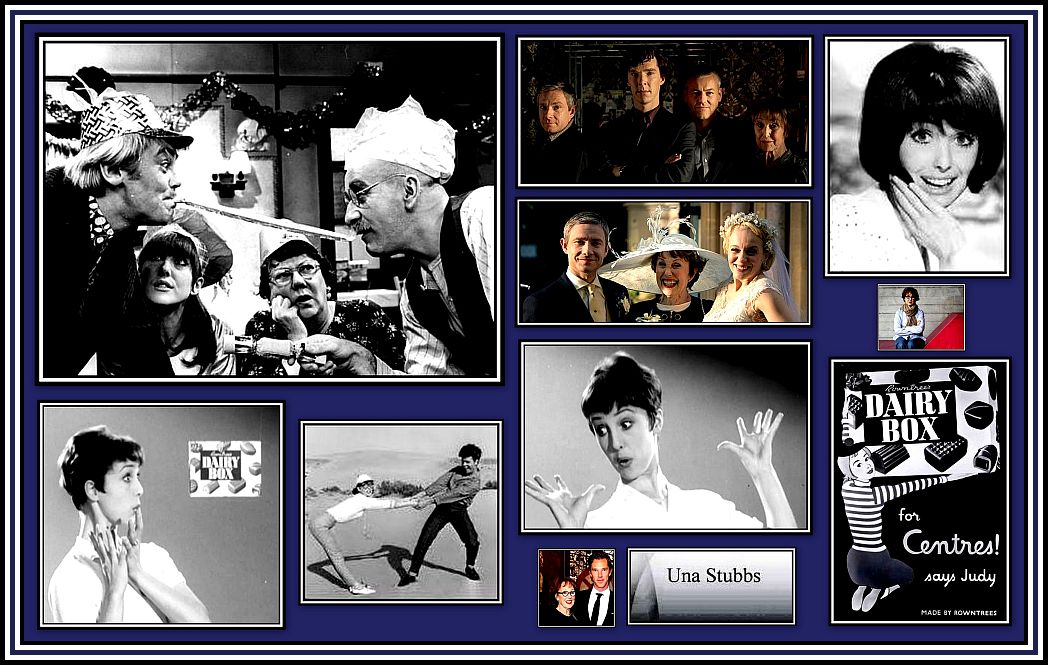 Una Stubbs, the Diary Box Girl and starred in ‘Til Death Us Do Part
Una Stubbs, the Diary Box Girl and starred in ‘Til Death Us Do Part
& now plays Mrs. Hudson in Sherlock and often appears on BBC Radio
I thought that the little shop, Miss Candy, was unique to the Century Theatre. Once I moved to Langley and discovered the Granada Theatre in Windsor Road, Slough, I noticed a little counter in its foyer that was also called Miss Candy. Naturally I then thought that both the shop and the counter were unique to these two theatres. However, years later, when I began to delve into the history of The Granada Theatre Circuit, I learned that these shops/counters had been added in the hope of cashing in of the cinema-going public’s sweet tooth and had been installed in most Granada Theatres. Despite this, I am still convinced that our Miss Candy was the best and employed the most beautiful and exotic of salesladies!
Although I cannot remember them, the Century Theatre also employed some very nice usherettes also dressed in seemingly silken uniforms.
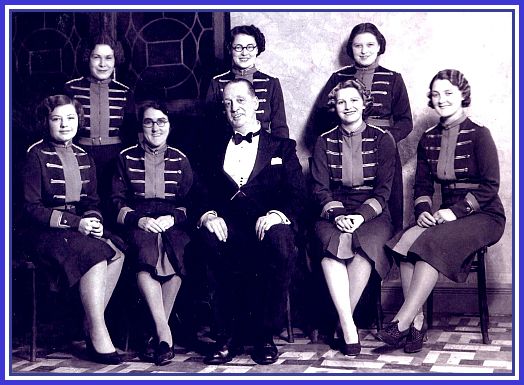 The Manager & Usherette Staff of the Regal Cinema, Eversham
The Manager & Usherette Staff of the Regal Cinema, Eversham
The photograph is reproduced by permission of Home Front History and
Rob Hemming, author of Shazam – The Book (The History of a Regal Cinema)
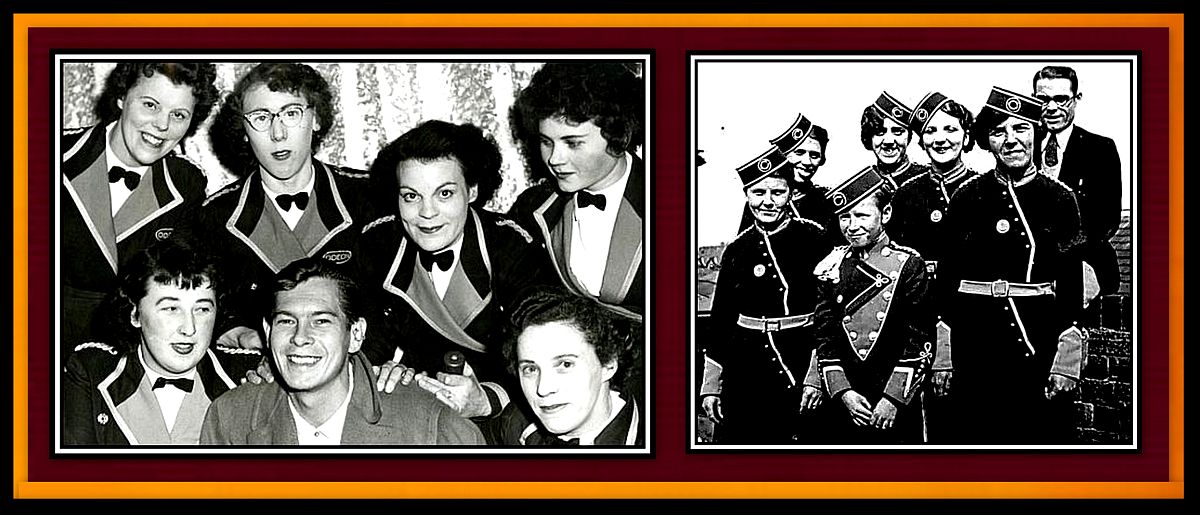 Left: Usherettes with Johnnie Ray at the Odeon Nottingham
Left: Usherettes with Johnnie Ray at the Odeon Nottingham
Right: Staff of the Central Cinema Stourbridge (June 1935)
I remember seeing two films, a cartoon and a news report on that first visit and also enjoyed some sweets from Miss Candy and an ice cream purchased from the tray of the Ice Cream Lady who walked up and down the aisle during the interval.
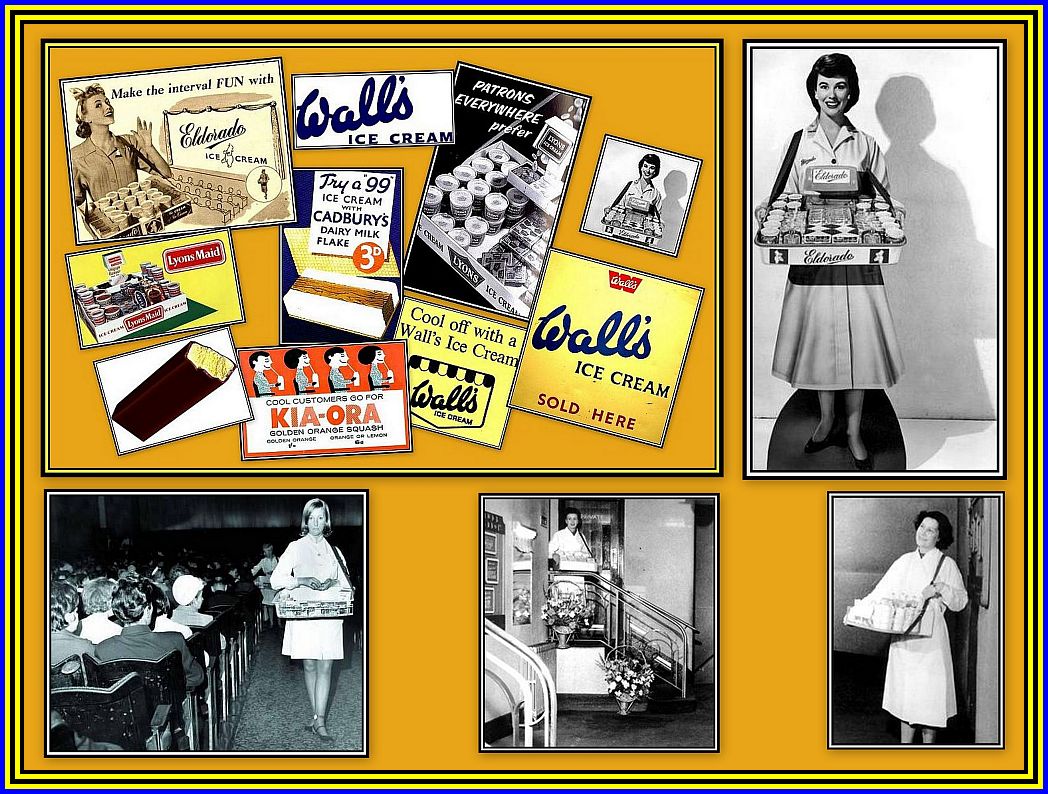 Ice Cream Ladies with their Trays
Ice Cream Ladies with their Trays
I can only recall one of the films that we saw, Mohawk, which at that time, was exactly the kind of film I liked. Firstly, it was in colour, and secondly, although it was a western, it had lots of Indians in it. I have always sided with the Indians and used to get most annoyed when the Cavalry rode in and killed many and rounded up the survivors to take back to a reservation! I remember that I found it odd that the hero of the film was an artist. I was not expecting this.
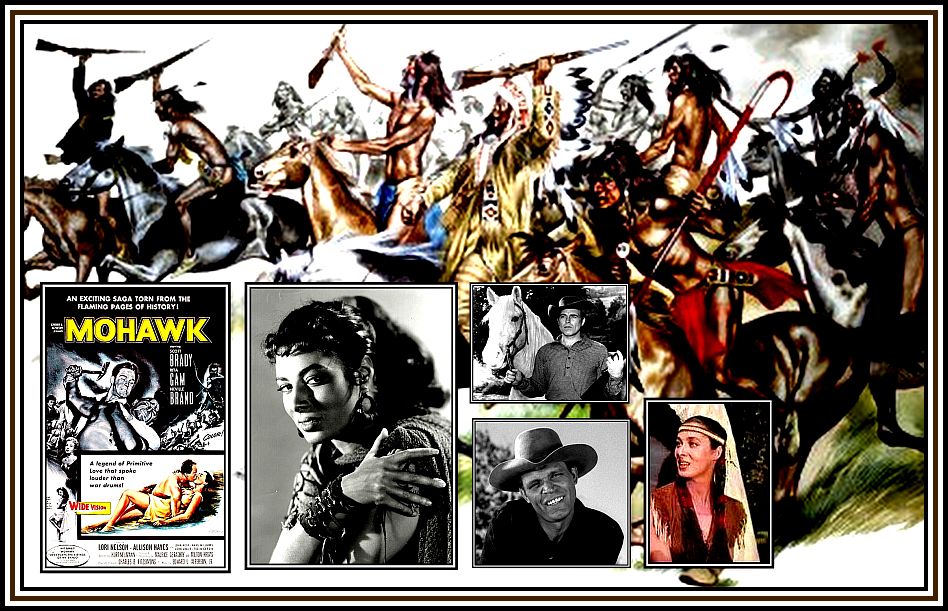 Left: Film Poster; Left Centre: Rita Gam shown here in the classic, The Sign of the Pagan
Left: Film Poster; Left Centre: Rita Gam shown here in the classic, The Sign of the Pagan
Right Centre, Top: Scott Brady; Right Centre, Bottom: Neville Brand
Right: Rita Gam shown here in Mohawk
I cannot recall much else about the Theatre despite going there often once we moved to Langley. I don’t think it had a circle, but I cannot swear to this. After my first visit, I saw several 20th Century Fox’s CinemaScope Productions including Good Morning, Miss Dove and The Best Things in Life are Free and also the war film, Attack, with the great Jack Palance.
Sadly, soon after we moved to Slough, Granada Theatres closed the Century Theatre. As the Circuit operated both the Granada and Adelphi Theatres in the town, it most likely thought that it did not need a third especially since the sale of cinema tickets was in decline.
I was surprised and very upset that the Circuit chose the Century to be closed, as it had obviously become my favourite Slough cinema thanks in great part to the presence of the exotic and unsmiling Miss Candy, as well as to the decor of the Theatre. Personally, I would have closed the Adelphi Theatre in a flash. However, the Adelphi Theatre offered several advantages to it remaining open compared to the Century.
The Adelphi was the largest theatre in the town and was fully equipped for theatrical presentations. With the decline of cinema admissions, the Adelphi was proving not be a money maker. At this time, all circuits were suffering from the decline and were desperately seeking ways to attract customers back to their buildings on a regular basis. Rock ‘n’ Roll was now big business, as fans now wanted to see the singers whose records they were buying. As a result, a several enterprising entrepreneurs began bringing a number of popular singers, groups and comedians to act as Masters of Ceremonies together and booking them collectively into cinemas and theatres throughout the country. These tours proved very popular during the late 1950s and 1960s. The Adelphi Theatre with its large seating capacity and equipped stage and dressing rooms proved ideal for becoming such a venue and so was to prove of greater value to The Granada Theatre Circuit than the Century in those changing times!
The Century Theatre closed on 27th January, 1957 and alas, I never saw Miss Candy again. Over the years, I have often wondered what became of her.
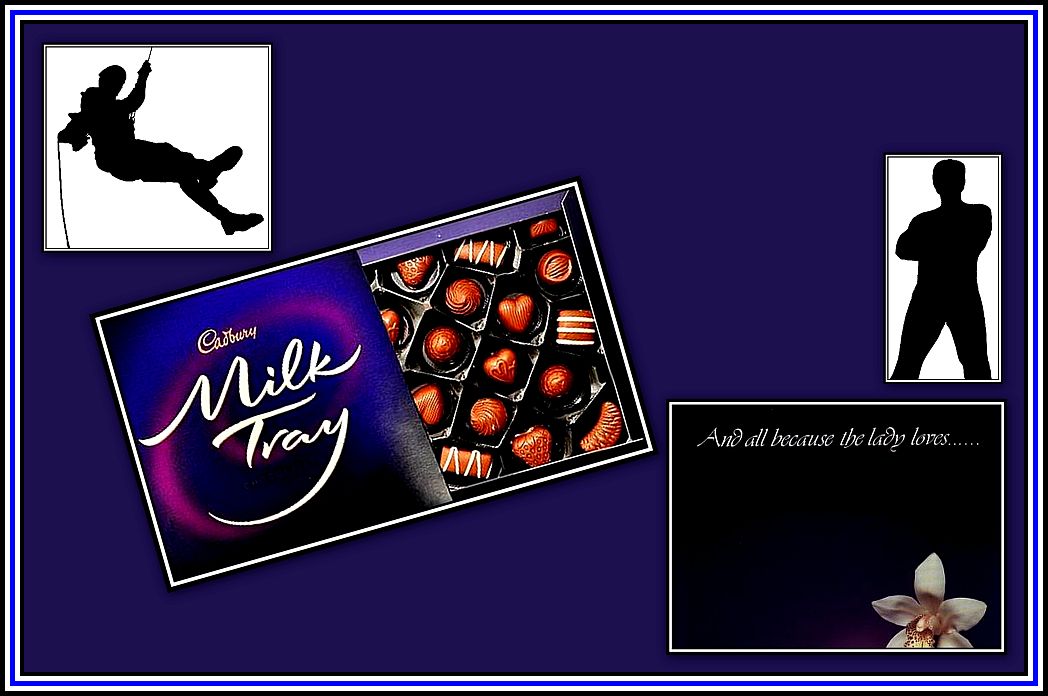 And all because the lady loves Milk Tray …….
And all because the lady loves Milk Tray …….
The Theatre became a Waitrose Supermarket and not demolished, as I had thought. I am told that the ceiling of the Theatre could be seen.* It took me a good while before I could bring myself to enter this establishment. In addition, I have never been able to like the Waitrose Supermarket Chain or its parent company, John Lewis, and suspect that my irrational reasoning stems from its take-over of the Century Theatre.
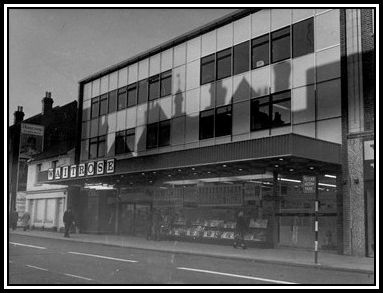 Waitrose Supermarket, 1957, on the site of the Century Theatre Slough
Waitrose Supermarket, 1957, on the site of the Century Theatre Slough
I would like to thank Mr. Andrew Williams for this information:
The supermarket was itself demolished in the late 1980s to make way for the Observatory Shopping Centre, which I have also never liked and never enter during my visits to Slough!
What is the expression? What goes around, comes around!
——oooOOOooo——
I have received a letter from a reader who kindly was willing to share his memories of the cinemas and theatres that he visited as a child and young man while living in Cardiff. I thought this account worthy of being shared here:
I remember from my childhood the cinemas of Cardiff. There were a number in the centre and included:
The Capitol, which I think was part of the Rank Circuit, the Empire (later the Gaumont), the Queens, which was an ABC cinema, the Olympia, the Odeon, the Grand, the Park Hall, the Central and the Pavilion.
There were a number of other cinemas in other areas of the city and included: the Plaza, the Monico, the Splott, the Coliseum, the Globe, the County, the Gaiety, the Washington, the Tivoli, the Avenue and the Rialto.
As a child during the immediate post war years, my mother would take me to town each week and we would meet my Dad and have afternoon tea at the Carlton Restaurant which had a small orchestra that playing for the diners. Afterwards we would then go to one of the cinemas. I loved it. When my Dad was posted to Germany for two years, my Mum continued to take me to the cinema each week, but whenever my Dad had a weekend pass and came home to Britain, we would meet him in London and always spent an evening at the cartoon cinema in Piccadilly Circus (or was it Oxford Circus?).
When my Dad returned home permanently, we moved to our pre-War home in Rhiwbina Garden Village on the outskirts of Cardiff. The local cinema was the Monico and we went there at least once a week and often twice as the programme changed mid-week. Also I went to the Saturday morning kids’ cinema which cost 6d at the time. Later during my teenage years, I had a friend whose father was a cinema manager, initially at the Splott cinema and then at the Plaza which was closer to my home and much more “up market” than the Splott. I went often with my friends to the Plaza as well as continuing to go to the Monico. Occasionally we went into town to one of the cinemas there.
My friend’s father was also able to get tickets to Trade Shows and for jazz concerts being held at The Capitol cinema. I remember enjoying the Trade Shows and also the concerts. We were fortunate enough to get to see Ray McKinley & The Glenn Miller Orchestra, Ella Fitzgerald, Joe Williams & the Count Basie Orchestra, Duke Ellington, Dave Brubeck, Stan Kenton, Ted Heath, Tubby Hayes-Ronnie Scott and The Jazz Couriers, and at a different venue, The Modern Jazz Quartet.
Unfortunately all of the cinemas that I once knew are now gone. My beloved Monico was kept open for several years by an enthusiast, but eventually, perhaps 5 or 6 years ago, was demolished and replaced by a block of flats.
The Theatres in Cardiff were the New Theatre and The Prince Of Wales Theatre. Again my Mum and Dad would take me to the theatre frequently, in particular to see the D’Oyly Carte or The Welsh National Opera. As a result, I developed a love for the operettas of Gilbert & Sullivan and of Operetta and Opera. As a teenager, I often went with my friends to the theatre to see plays. We usually sat high up in “The Gods” as seating here was cheap!
Bob Sanders from Cardiff
——oooOOOooo——
ACKNOWLEDGEMENTS
I would like to thank Mr. Simon Glenhill for providing information on the Hammond Organ.
I also would like to thank Mr. Bob Sanders and Mr. Stephen Dutfield for their contributions and Mr. Andrew Williams for his correcting my errors regarding The Century Theatre and Waitrose.
——oooOOOooo——
Click here to go to PART TWELVE: THE SLOUGH GRANADA THEATRES & MISS CANDY
PAGE THREE – THE GRANADA & ADELPHI THEATRES OF SLOUGH
——oooOOOooo——
Click here to return to PART TWELVE: THE SLOUGH GRANADA THEATRES & MISS CANDY
PAGE ONE – SLOUGH, SLOUGH STATION & STATION JIM
——oooOOOooo——
Click here to go to PART THIRTEEN: THE END OF AN ERA
——oooOOOooo——
Click here to return to THE GRANADA THEATRE CIRCUIT Home Page
——oooOOOooo——
Click here to return to the TABLE OF CONTENTS
——oooOOOooo——

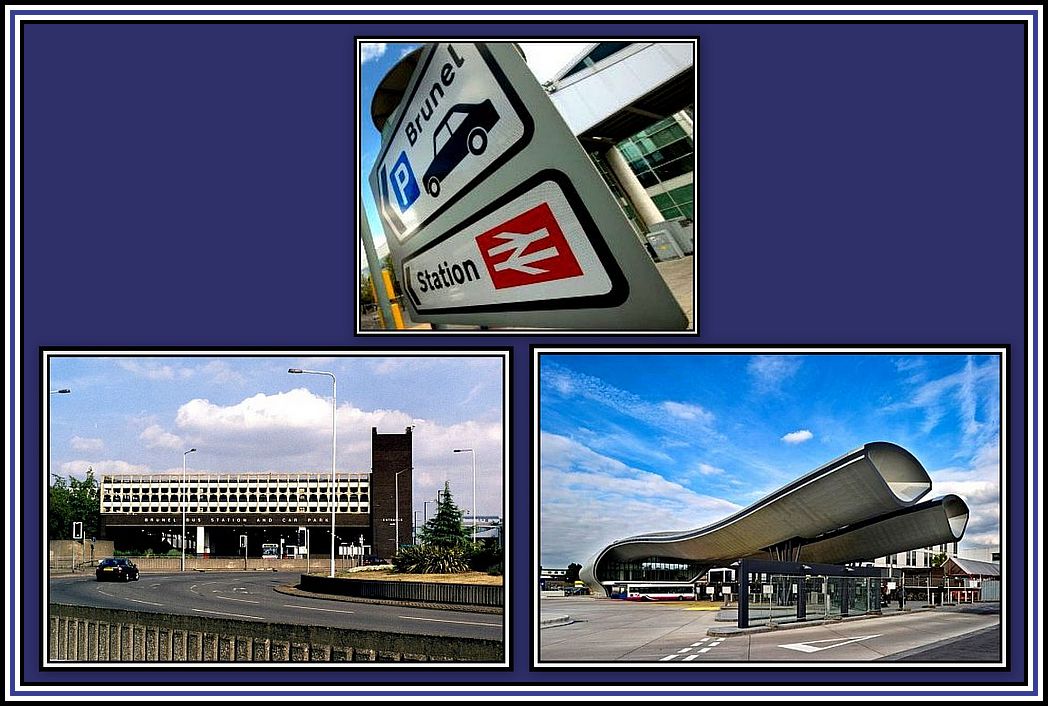
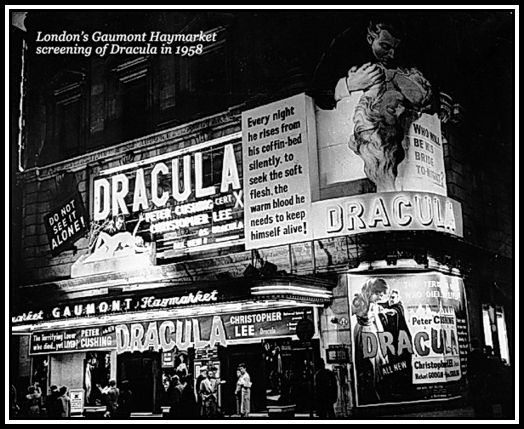


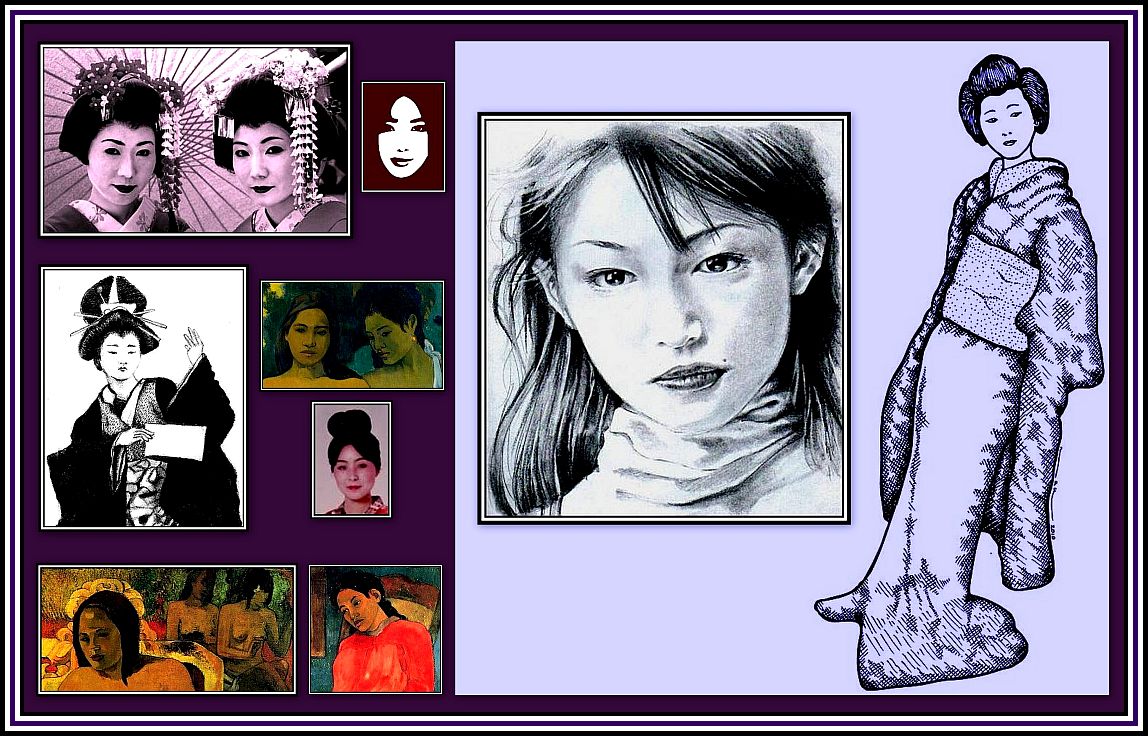
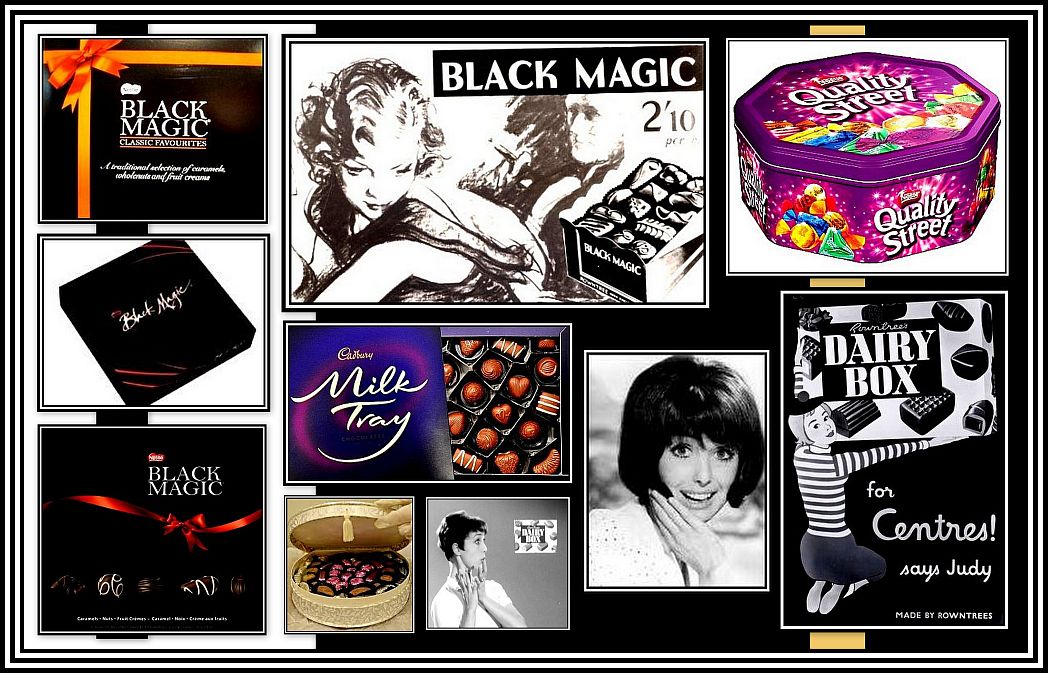
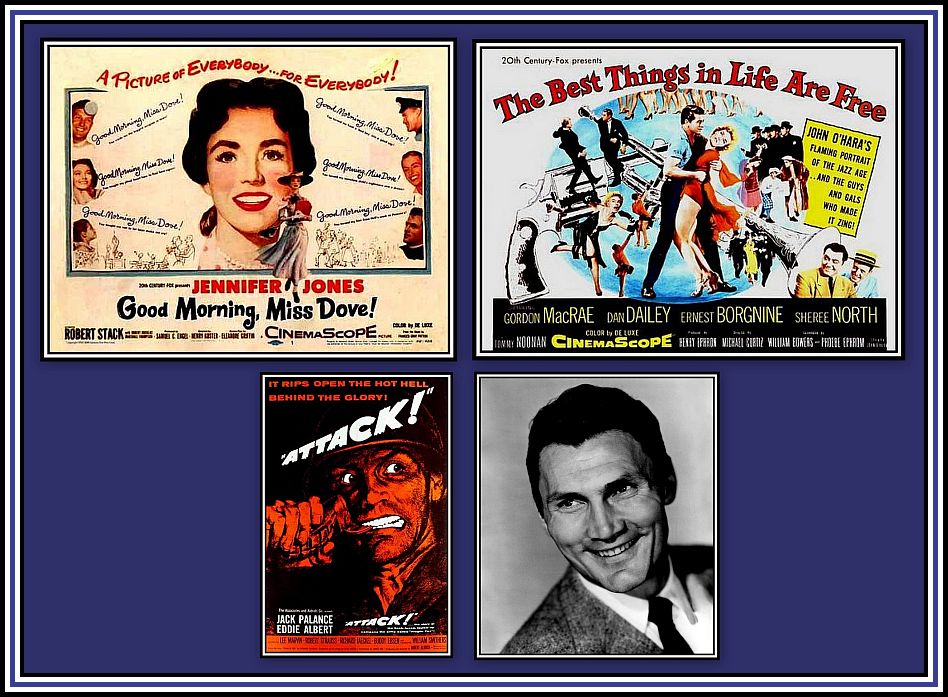
I have read with great interest your tales of life in Slough, 1956 onwards, and enjoyed the memories that it evoked. I lived in William Street from 1939 until November 1955 (not a hundred yards from Slough Tech) and on the request oif my grandchildren have recently put together my memories of Slough, in particular William Street, My House (No. 55) my schools – Thomas Gray, Tonman Mosley and of course the Orchard, and growing up in Slough, sadly I don’t have many photo’s only memories, so my memories tend to be on the ‘wordy’ side rather than pictorial. I did a considerable amount of ‘courting’ in the back row of the Century!
Dear Charles, this is history writing at its best! I can’t believe the quality of your images and the detail of your text. I knew I had heard of Slough, but I didn’t remember until you mentioned it that it was from the TV show “The Office.” By the way, I was pleased to see the French expression you cited:
“Quand on a une certaine réputation, il a tellement difficle de se libérer” – Once one has a certain reputation, it is very difficult to rid oneself of it.
I’m studying Spanish and just leaned a similar refrain:
“Cría fama y acuéstate a dormir” – Once you build a bad/good reputation, it stays forever.
Thank you Linda for your kind message. Charles. Ole!
What a very informative website. My name is Graham Wilson, My Great Great Grandfather was Herbert George Wilson, he was landlord of the Crown Hotel on the High street, Slough C1900-1915 and in 1910 opened the first Cinema in Slough begind the Crown Hotel and formed the Slough Picture Hall Company Ltd and then went on in 1921 and formed The Slough Picture Theatre Company Ltd, which owned the Palace Cinema documented on this website. Herbert Wilson was also Managing Director of the Oxford Cinematograph Company (1922)Limited which owned the Cinema in George Street Oxford. I am currently researching my family tree, and an trying to trace what happened to my Great Great Grandfather after he ran the Cinema. I am intrigued to know what happened to the companies he used to run; can anyone help? Many thanks
I am researching the ancestry of a friend, Wendy Andrews, who is a descendant of Herbert G Wilson’s wife, Jane (nee Hogben formerly Andrews). Jane married Herbert after the death of her first husband in Elham Kent & moved to Slough. I am currently trying to find them on the 1911 census – I know they were still in Slough, having found several references (including yours) to the hotel & Herbert Wilson.
Jane Wilson had a son by her first husband (Frederick Andrews, a Kent farmer 40 years her senior) the son being Frederic(k) William Danzey Cresswell Andrews b. 1881 and the latter is the great grandfather of Wendy. If you have not looked up Jane’s father’s background (Danzey Somerville Cresswell b 1825), then I recommend you do – it’s online. You are welcome to contact me and perhaps, also, we can share research.
Waitrose did not knock down the Century Cinema. The supermarket was housed in the cinema. The upper floor warehouse still had the cinema ceiling and the main office was in the projection room until it closed and was demolished in 1989. The site of Waitrose/ Century Cinema is now the West entrance to the Observatory shopping centre and not the Wilco’s.
my parents also left london and settled in slough
they came from the east end and grandmother lived in petticoat lane
on the corner where the baker was not far from Blooms.
I loved going to London and my father took me to the Gold market in cutler street
My grandfather had a shop in Farnham road close to the Ambassadoor
I live in Belgium and wild horses could never drag me back to Cippenham not far from the Essoldo
I really enjoyed your article and would to hear from you
P.S. Mr. Merrill was manager of the Ambassadoor
see above
Tony
Did you live in Cumberland avenue.
John Evans
I lived in Slough on Shackleton Road from 1940 until I emigrated to Canada in 1955. I was lucky enough to win a place at Slough Grammar School for boys and the education I received there carried me upward through many good jobs, probably better than if I had stayed around for university. My family moved out of Slough many years ago but when I go back to visit I sometimes drive around my old haunts, if I can find them. Sad to say it is not the nice town I remember.
Having lived and worked in six different countries I have been an American for 60 years and am now retired, living in Las Vegas.
Thank you for visiting my website and leaving a comment. Charles